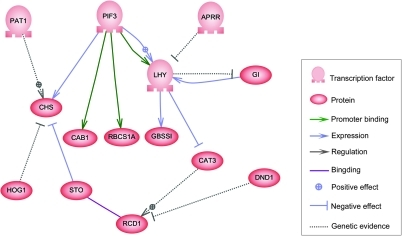Lecture 14
Gene Networks
Starting with this lecture we will shift our attention in this course. Instead of focusing on physical characteristics of biological systems we will focus on functional control of biological systems.
Here is a simple example of a gene regulatory network.

In our discussions we will talk about how genes can express something, they can help activate something or repress something. We will use the following symbols to represent those actions.
\[\begin{align*} \bigcirc &: \text{constitutive expression} \\ \bigcirc \rightarrow \bigcirc &: \text{activation} \\ \bigcirc \dashv \bigcirc &: \text{repression} \end{align*}\]Gene Regulation
Unregulated Gene Expression
Consider the following system:
- RNA polymerase moves down a part of DNA and transcribes gene Y
- mRNA is produced
- mRNA is translated into proteins
- mRNA and the protein degrade at their respective rates.
In summary, our system has production and degradation events.
Rate Equations
Lets describe these events as rate equations but first, lets set a couple of definitions.
\[\begin{align*} \text{[ mRNA ]} &\equiv m \\ \text{[ proteins ]} &\equiv y \\ \text{[ DNA ]} &\equiv d_0 \end{align*} \\ \frac{dm}{dt} = k_1 d_0-r_1 m\\ \frac{dy}{dt}=k_2 m - r_2 y\]Timescales
Transcription and translation occur on different timescales. Typically the degradation time of mRNA is much shorter than that of the protein.
\[r_1^{-1} < r_2^{-1}\]Therefore transcription is occurs much faster than translation.We use this to justify making a quasi-steady-state approximation.
\[\Rightarrow \frac{dm}{dt} \approx 0 \\ k_1 d_0-r_1 m = 0 \\ \Rightarrow m=\frac{k_1d_0}{r_1}\]Plugging this into the rate equation for the proteins yields:
\[\frac{dy}{dt}=\frac{k}{v}-ry \\ \Rightarrow y(t)=\left(y_0-\frac{k}{rv}\right)e^{-rt}+\frac{k}{rv} \\ k= \frac{k_1k_2}{r_1}, \ \ r_2\rightarrow r, \ \ d_0=\frac{1}{v}\]Gene Activation
Let X be the activation molecule. X binds to an activation site on DNA which allows for the production of protein Y.
\[\text{X} \rightarrow \text{Y}\]The production and degradation events in this system can be summarized as the following:
\[\text{X}+\text{DNA} \rightleftharpoons^{k_+}_{k_-} \text{X-DNA complex} \xrightarrow{k}\text{protein}+\text{X}+\text{DNA}\]As before we want to describe this process in terms of rate equations. Let’s make a couple of new definitions to help us with that.
\[\begin{align*} \text{[ Activator X ]} &\equiv x \\ \text{[ X-DNA complex ]} &\equiv c \\ \text{[ DNA ]} &\equiv d \end{align*} \\ \dot{x} = (k_- + k)c-k_+ xd \\ \dot{d}=\dot{x} \\ \dot{c}=k_+ xd-(k_- + k)c = -\dot{x}\]Notice that the concentrations are conserved.
\[d+c=d_0 = \frac{1}{v}\]We are again assuming a quasi-steady-state. We assume that the binding and unbinding of the activator X with DNA is very fast.
\[\Rightarrow \dot{c}\approx0\]Using these assumptions we can solve for \(c\) in terms of our other variables and constants and in turn get an equation for \(\dot{y}\).
\[c = \left(\frac{k_+ x/v}{k_+ x + k_-+k}\right) \\ \dot{y} = \frac{kk_+ x/v}{k_+ x + k_-+k} - ry \\ \text{let } K_d\equiv \frac{k_- + k}{k_+} \ \ \ \text{and} \ \ \ f_+(x)=\frac{k}{v}\frac{x}{x+K_d} \\ \Rightarrow \dot{y}=f_+(x)-ry\]The function \(f_+(x)\) is know as a Michaelis–Menten function and it looks something like this…

Gene Repression
Now lets consider the case of X behaving as a repressor instead of an activator.
\[\text{X} \dashv \text{Y}\]The production and degradation events in this system can be summarized as the following:
\[\text{X}+\text{DNA} \rightleftharpoons^{k_+}_{k_-} \text{X-DNA complex}\\ \text{DNA} \xrightarrow{k}\text{protein}+\text{DNA} \\ \text{protein} \xrightarrow{r}\emptyset\]In a similar fashion as the activator case, we can get an expression for \(\dot{y}\).
\[\dot{y}=f_-(x)-ry\]Written with StackEdit.
